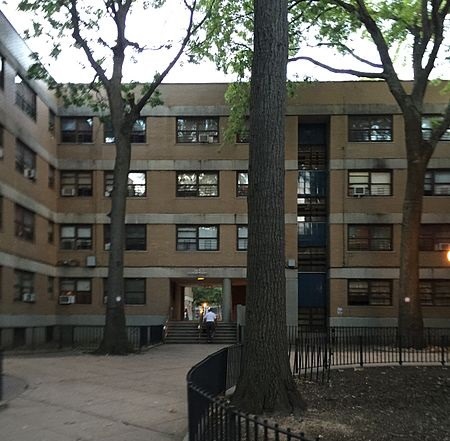
In “The Scourge of Sexual Harassment in Public Housing,” author Brentin Mock assembles an impressive review of incidents of sexual harassment against women living in public housing. Mock describes a lawsuit brought on behalf of public housing tenants in Baltimore who allege that they were victims of housing authority employees and that higher-ups ignored their complaints:
The lawsuit states that executives in the city’s housing authority either ignored these complaints for years, or discouraged women from pressing forward with them. Women in the suit say they’ve had to go without heat and live with broken appliances because they refused maintenance workers’ sexual requests. In public housing, residents often have to rely on housing-authority staff for repair work either because they can’t afford their own handymen, or because of rules restricting them to staff help.
In addition to focusing on the Baltimore case, Mr. Mock gives attention to cases of sexual harassment arising in Kansas City, Kansas; Scotland County, North Carolina; and Bossier City, Louisiana. A HUD blog posting cites some additional examples of recent cases. From the examples given, the pattern seems to be employees acting badly and administrators ignoring or covering up abuses. Still, sexual harassment in public housing is not a new story. Back in 2010, NPQ’s Rick Cohen covered the departure of Philadelphia’s head of public housing under a cloud of charges, including sexual harassment.
Last month, HUD’s office of Fair Housing and Equal Opportunity issued new guidance to help define what constitutes harassment in rental housing. HUD is aiming to create uniform standards for evaluating claims of hostile environment and quid pro quo harassment in the housing context. According to HUD:
Hostile Environment Harassment involves subjecting a person to unwelcome conduct that is sufficiently severe or pervasive such that it interferes with or deprives the person the right to use and enjoy the housing. Quid Pro Quo Harassment involves subjecting a person to an unwelcome request or demand and making submission to the request or demand a condition related to the person’s housing.
There are two key points for property owners or administrators. First, “owners” are responsible for the misbehavior of their subordinates. The HUD regs define this as vicarious liability, saying, “The proposed rule simply adds a provision stating that a person may be vicariously liable for the discriminatory acts of his or her agent.” Second, these new regulations cover all rental housing, not just federally assisted. This is because the Federal Fair Housing Act applies to most rental housing in the U.S. HUD’s new guidance will remain open for public comment until December 21, 2015.
Sign up for our free newsletters
Subscribe to NPQ's newsletters to have our top stories delivered directly to your inbox.
By signing up, you agree to our privacy policy and terms of use, and to receive messages from NPQ and our partners.
The problem of sexual harassment of female tenants is likely to occur in any rental housing where supply is scarce. Rent-assisted units are a frequent source of complaints, but in tight markets, tenants may tolerate harassment for fear of retaliation and possible displacement or homelessness. The current rental affordability crisis suggests that enforcement agencies can expect more cases everywhere, not just in public housing.
While “quid pro quo” is pretty easy to recognize, one’s understanding of hostile environment may benefit from more specific examples, drawn from cases and tenant reports.
- Abusive language/bullying. A male landlord berates female tenant for being late on rent using gender-specific terms and a loud voice and menacing manner, in front of neighbors.
- Abuse of entry. A maintenance man (allegedly) knocks and then, without waiting, keys himself into a female tenant’s apartment finding her in her nightclothes. In another case, a maintenance man only comes to make repairs between 2:30 PM and 4 PM, when teenage daughters are home alone.
- Voyeurism/stalking. A maintenance man hovers outside female tenant’s ground floor window on the pretext of “doing an inspection” of the gutters by her unit. Later, he’s seen hanging around same tenant’s unit entry door after working hours.
- Intrusive inspection. Property owner rifles through female tenant’s lingerie drawers as a part of a “housekeeping” inspection.
- Banned guests. Female tenant threatened with eviction because her former boyfriend was caught trying to break into her apartment.
- Nuisance call evictions. A landlord evicts a female tenant after being advised by local police that the tenant was making too many calls for help.
Besides the stigma of being a victim of sexual harassment and the fear of eviction as a result of bringing a charge, the issue of “proof” is always tough. By its nature, sexual harassment is normally between two people without witnesses. So how does a prospective complainant document her charge? Fair housing experts suggest:
- Report the harassment early and report it often. Don’t wait until you are facing eviction or termination to talk about the harassment. At that point, the assumption is that the victim is making up the charges in an effort to avoid the eviction or termination.
- Keep records of your complaints to the owner or manager.
- Make screen shots or hard copies of text messages or emails received from a harasser.
- Record incriminating conversations if your state law is a one-party consent state.
- Retain phone messages that might show evidence of harassment.
- Keep a diary that document encounters including the time, place, and nature of the incident.
- Find other victims to establish a pattern of practice of harassment. Often a victim believes she is the only one being targeted, but that is not usually the case. If you find another victim, ask her to cooperate in the investigation and report her story as well.
The new HUD regs cover more than just female renters. HUD describes hostile environment as occurring when “a person is subjected to unwelcome conduct that is sufficiently severe or pervasive such that it interferes with or deprives the victim of his or her right to use and enjoy the housing or to exercise other rights protected by the Act.” Presumably this definition would apply to any protected class under the Federal Fair Housing Act. In particular there’s a strong argument that transgender discrimination is covered by the Federal Fair Housing Act. Moreover, LGBT households are protected by federal regulations with respect to federally-assisted housing and presumably covered by the definitions in the new HUD notice.
What about persons with disabilities, who are often subjected to ridicule or disparagement? Michael Kane, Executive Director of the National Alliance of HUD Tenants (NAHT) says, “Bullying of vulnerable tenants by both on-site property managers and occasionally other residents, is an epidemic in HUD subsidized senior and disabled housing. NAHT gets phone calls from terrified residents from across the US, and it’s a strikingly similar story. HUD has yet to acknowledge the problem, let alone take action to address it.”
NAHT has convened a Task Force to recommend reforms to HUD’s Management and Occupancy Review protocols to jump-start a HUD response. These proposed regulations might provide some guidance in cases where the harassment comes from owners or agents (not other residents) and where the victim is a member of a federally protected class.—Spencer Wells











